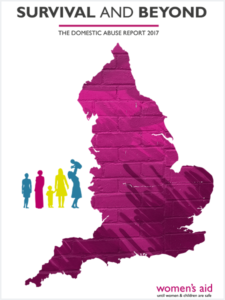Survival and Beyond: The Domestic Abuse Report 2017 (published 2018)
 Survival and Beyond looks at service provision and the needs of women and children including change over time from 2010 to 2017. We present the findings of the Women’s Aid Annual Survey 2017 alongside information from Routes to Support (the UK violence against women and girls service directory), On Track (the Women’s Aid case management and outcomes monitoring database), the Femicide Census (developed in partnership with Karen Ingala Smith) and the No Woman Turned Away Project.
Survival and Beyond looks at service provision and the needs of women and children including change over time from 2010 to 2017. We present the findings of the Women’s Aid Annual Survey 2017 alongside information from Routes to Support (the UK violence against women and girls service directory), On Track (the Women’s Aid case management and outcomes monitoring database), the Femicide Census (developed in partnership with Karen Ingala Smith) and the No Woman Turned Away Project.
© Women’s Aid 2018
Please cite this report as:
Women’s Aid (2018) Survival and Beyond: The Domestic Abuse Report 2017. Bristol: Women’s Aid.
Note the report was updated on 20th March to correct errors in some of the tables.
Key Findings
The services users:
- An estimated 3,557 women with 3,919 children stayed in refuge on the Day to Count (4th July 2017) across all services in England
- An estimated 25,727 women were using community-based services in the Week to Count (3rd – 7th July 2017) across all services in England
- Services supported an estimated 13,414 women in refuge services and 154,306 women in community based services throughout the year 2016 – 2017
Demand exceeds capacity:
- 24.3% of referrals in 2016/17 to community-based services responding to the annual survey were declined
- 60.0% of referrals in 2016/17 to refuge services responding to the annual survey were declined, one in five of all referrals were declined due to lack of space in the refuge
Access to services is more challenging for some groups of women:
Of the 11,187 vacancies listed on Routes to Support during 2016/17:
- only 1.7% (n=195) had wheelchair access with a further 1.3% (n=150) being suitable for a woman with limited mobility
- only 766 out of 11,187 vacancies (5.4%) posted on Routes to Support would accept applications from women with no recourse to public funds
- Less than half could take a woman with two children, this reduces to less than one in five for a woman with three children
Funding challenges:
- 46.3% (57 services of 123) of organisations responding to the Women’s Aid Annual Survey 2017 were running an area of work without dedicated funding during 2016/17
- 20.3% of organisations (24 organisations) received 25% or less of their funding from the local authority
